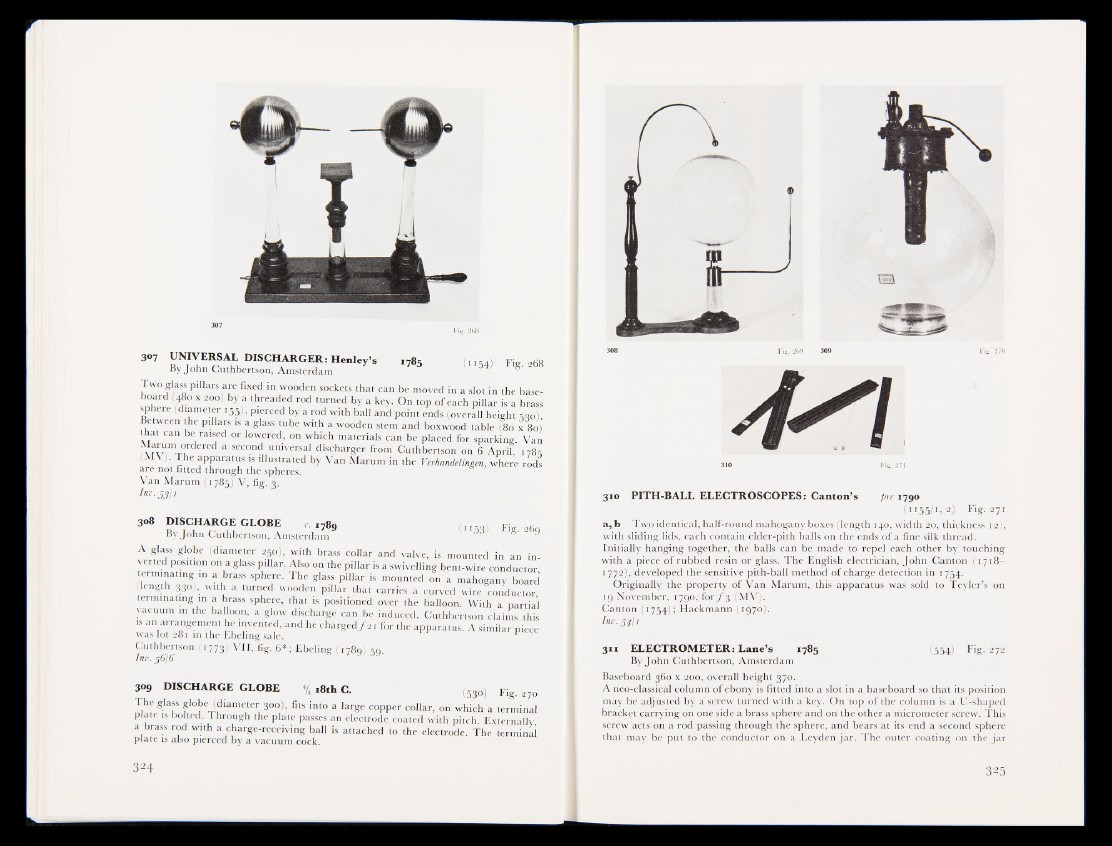
307 UNIVERSAL DISCHARGER: Henley’s I785 !*■ 154l"' Fig- 268
B y J o h n C u t h b e r t s o n , A m s t e r d a m
T w o g la s s p i l l a r s a r e f i x e d in w o o d e n s o c k e t s t h a t c a n b e m o v e d in a s lo t in t h e b | e -
b o a r d (4 8 0 x 20 0 ) b y a t h r e a d e d r o d t u r n e d b y a k e y . O n t o p o f e a c h p i l l a r is a b r a s s
s p h e r e ( d i a m e t e r 1 5 5 ) , p i e r c e d b y a r o d w i t h b a l l a n d p o in t e n d s ( o v e r a l l h e i g h t 3 3 0 J
B e tw e e n t h e p i l l a r s is a g la s s t u b e w i t h a w o o d e n s t em a n d b o x w o o d t a b l e (80 x 8 f
t h a t c a n b e r a i s e d o r l o w e r e d , o n w h i c h m a t e r i a l s c a n b e p l a c e d f o r s p a r k in g . V a n
! f ' r m^ deTed a s e c o n d u n i v e r s a l d i s c h a r g e r f r o m C u t h b e r t s o n o n 6 A p r i l , 1 7 8 s
' r 6 j P P a r a t u s 1S i l l u s t r a t e d b y V a n M a r u m in t h e Verhandelingen, w h e r e r o d s
a r e n o t f i t t e d t h r o u g h t h e s p h e r e s .
V a n M a r u m ( 1 7 8 5 ) V , fig. 3 .
Inv. 53\i
308 DISCHARGE GLOBE c. i 789 Fif;-gfig
By John Cuthbertson, Amsterdam
A glass globe (diameter 250), with brass collar and valve, is mounted in an inverted
position on a glass pillar. Also on the pillar is a swivelling bent-wire conductor
terminating m a brass sphere. The glass pillar is mounted on a mahogany board
(length 330), with a turned wooden pillar that carries a curved wire conductor
terminating m a brass sphere, that is positioned over the balloon. With a partial
vacuum in the balloon, a glow discharge can be induced. Cuthbertson claims this
is an arrangement he invented, and he charged ƒ 21 for the apparatus. A similar piece
was Jot 281 in the Ebeling sale. ^
Cuthbertson (1773) VII, fig. 6*; Ebeling (1789) 59.
Inv. j6 /6
309 DISCHARGE GLOBE % 18th C. (5 3 0£ Fig. 2?0
The glass globe (diameter 300), fits into a large copper collar, on which a terminal
plate is bolted. Through the plate passes an electrode coated with pitch. Externally
a brass rod with a charge-receiving ball is attached to the electrode. The terminal
plate is also pierced by a vacuum cock.
310 PITH-BALL ELECTROSCOPES: Canton’s pre 1790
(n55/i,2) Fig. 271
a,b Two identicalflmalf-round mahogany boxes (length 140, width 20, thickness 12),
with slidinmids, each contain elder-pith balls on the ends of a fine silk thread.
Initially hanging together, the balls can be made to repel each other by touching
with a piece of rubbed resin or glass. The English electrician, John Canton (1718fl
1772), developed the sensitive pith-ball method of charge detection in 1754.
Originally the property of Van Marum, this apparatus was sold to Teyler’s on
19 November, 1790, for ƒ 3 (MV)»
Canton (1754); Hackmann (1970):.
Inv. 5411
311 ELECTROMETER: Lane’s 1785 (554) Fig. 272
By John Cuthbertson, Amsterdai^Mj
Baseboard 360 x 200, overall height 370.
A neo-classical column of ebony is fitted into a slot in a baseboard so that its position
may be adjusted by a screw turned with a key. On top of the column is a U-shaped
bracket carrying on one side a brass sphere and on the other a micrometer screw. This
screw acts on a rod passing through the sphere, and bears at its end a second sphere
that may be put to the conductor on a Leyden jar. The outer coating on the jar